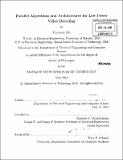Parallel algorithms and architectures for low power video decoding
Author(s)
Sze, Vivienne
DownloadFull printable version (25.68Mb)
Other Contributors
Massachusetts Institute of Technology. Dept. of Electrical Engineering and Computer Science.
Advisor
Anantha P. Chandrakasan.
Terms of use
Metadata
Show full item recordAbstract
Parallelism coupled with voltage scaling is an effective approach to achieve high processing performance with low power consumption. This thesis presents parallel architectures and algorithms designed to deliver the power and performance required for current and next generation video coding. Coding efficiency, area cost and scalability are also addressed. First, a low power video decoder is presented for the current state-of-the-art video coding standard H.264/AVC. Parallel architectures are used along with voltage scaling to deliver high definition (HD) decoding at low power levels. Additional architectural optimizations such as reducing memory accesses and multiple frequency/voltage domains are also described. An H.264/AVC Baseline decoder test chip was fabricated in 65-nm CMOS. It can operate at 0.7 V for HD (720p, 30 fps) video decoding and with a measured power of 1.8 mW. The highly scalable decoder can tradeoff power and performance across >100x range. Second, this thesis demonstrates how serial algorithms, such as Context-based Adaptive Binary Arithmetic Coding (CABAC), can be redesigned for parallel architectures to enable high throughput with low coding efficiency cost. A parallel algorithm called the Massively Parallel CABAC (MP-CABAC) is presented that uses syntax element partitions and interleaved entropy slices to achieve better throughput-coding efficiency and throughput-area tradeoffs than H.264/AVC. The parallel algorithm also improves scalability by providing a third dimension to tradeoff coding efficiency for power and performance. Finally, joint algorithm-architecture optimizations are used to increase performance and reduce area with almost no coding penalty. The MP-CABAC is mapped to a highly parallel architecture with 80 parallel engines, which together delivers >10x higher throughput than existing H.264/AVC CABAC implementations. A MP-CABAC test chip was fabricated in 65-nm CMOS to demonstrate the power-performance-coding efficiency tradeoff.
Description
Thesis (Ph. D.)--Massachusetts Institute of Technology, Dept. of Electrical Engineering and Computer Science, 2010. Cataloged from PDF version of thesis. Includes bibliographical references (p. 197-204).
Date issued
2010Department
Massachusetts Institute of Technology. Department of Electrical Engineering and Computer SciencePublisher
Massachusetts Institute of Technology
Keywords
Electrical Engineering and Computer Science.